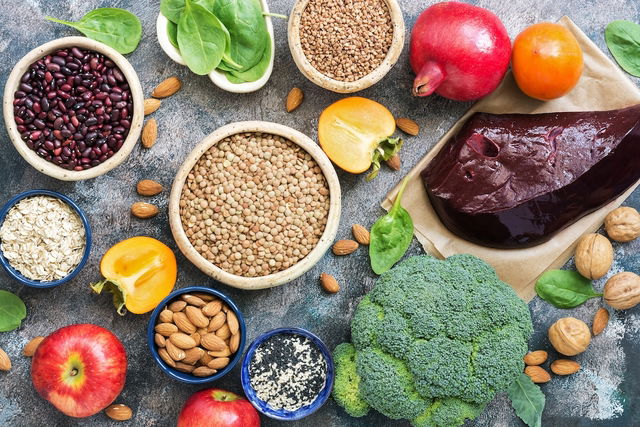Foods for anemia should be rich in protein, iron, folic acid, and B-complex vitamins, as these nutrients stimulate red blood cell production. Anemia is associated with decreased red blood cells and hemoglobin levels, and patients with anemia are encouraged to incorporate foods like meat, eggs, fish and spinach into their diet.
Iron-deficiency anemia is more commonly diagnosed in patients with reduced mobility, children who are growing or have an inadequate diet, or women who are pregnant. Food sources with the highest concentration of iron are usually animal-based and are typically better-absorbed in the gut. However, fruits that are rich in vitamin C, like oranges, kiwi and pineapple, can enhance iron absorption in the body and should also be included in an anemia diet.
Read more about the common symptoms of anemia and complete our online symptoms checker to assess your risk for this condition.

Types of food to eat
To treat anemia, you should eat foods that are rich in the following nutrients:
1. Iron
Iron-rich foods are extremely important for treating iron-deficiency anemia. This mineral stimulates the production of red blood cells.
There are two types of iron:
- Heme iron, which comes from animal based sources like meat, chicken, fish, liver, eggs and seafood. This type is generally better-absorbed into the body.
- Non-heme iron, which comes from foods that are iron fortified, and fruits or vegetables, bens, nuts, eggplant and leafy greens.
These foods should be included in your daily diet, ideally with a vitamin C source, like oranges, pineapples, strawberries, kiwis, or tangerines, so that the iron is better-absorbed.
In addition, some studies suggest that eating foods that are rich in vitamin A can also improve iron absorption, although more studies are needed to prove this effect.
Check out a long list of iron-rich foods so that you can incorporate many diverse sources into your diet.
2. Vitamin C
Consuming Vitamin C is also important for treating anemia, foods that are rich in this vitamin improve the absorption of high-iron foods, particularly plant-based iron sources.
Some foods that are rich in this vitamin are oranges, pineapple, strawberries, kiwi, tangerines and peppers. Check out a list of foods rich in vitamin C that you can consume with high-iron foods.
3. Folic acid
Folic acid, or vitamin B9, is needed to stimulate red blood cell production and ensure correct formation of hemoglobin (which is the substance responsible for transporting oxygen from red blood cells to the tissues).
This micronutrient can be found in foods like spinach, kale, liver, wheat germ and eggs.
4. Vitamin B12
A vitamin B12 deficiency can cause megaloblastic anemia, which is characterized by larger red blood cells and decreased white blood cells and platelets. This type of anemia can be prevented by regularly consuming foods that are rich in vitamin B12, like organ meat, eggs, milk and dairy products.
Also recommended: Top 16 Vitamin B12 Foods (& Recommended Daily Dose) tuasaude.com/en/vitamin-b12-foodsFood to avoid
When treating anemia, you should avoid foods that are rich in calcium when eating iron-rich foods. Calcium decreases iron absorption in the gut. Therefore, you should avoid drinking milk at lunch or dinner, when meats and other iron-rich foods tend to be consumed.
In addition, you should avoid drinking coffee, black tea or yerba mate during iron-rich meals, as these are rich in phytates and tannins, which also reduce iron absorption in the intestines.
Meal plan
The following table outlines a 3-day meal plan for treating anemia:
The quantities outlined in this meal plan vary depending on the person’s age, sex, activity level and health history. Ideally, you should see a registered dietitian for a thorough assessment, as he or she will then be able to develop a customized meal plan that meets your health goals and nutritional necessities.
In addition to addressing your eating habits, a doctor or registered dietitian can also consider whether supplementation with iron or other micronutrients, like vitamin B12 or folic acid, is necessary.
